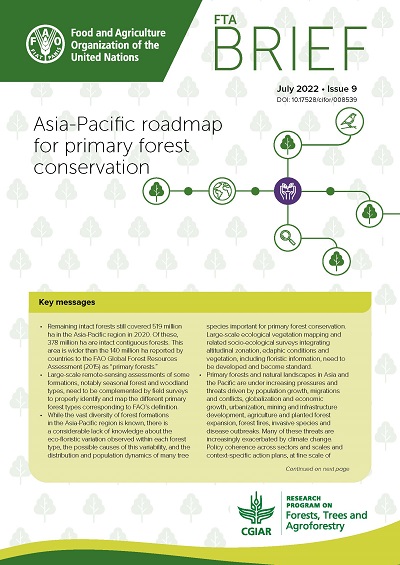Asia-Pacific roadmap for primary forest conservation
Resource information
Date of publication
Mayo 2022
Resource Language
Pages
189
License of the resource
- Remaining intact forests still covered 519 million ha in the Asia-Pacific region in 2020. Of these, 378 million ha are intact contiguous forests. This area is wider than the 140 million ha reported by countries to the FAO Global Forest Resources Assessment (2015) as “primary forests.”
- Large-scale remote-sensing assessments of some formations, notably seasonal forest and woodland types, need to be complemented by field surveys to properly identify and map the different primary forest types corresponding to FAO’s definition.
- While the vast diversity of forest formations in the Asia-Pacific region is known, there is a considerable lack of knowledge about the eco-floristic variation observed within each forest type, the possible causes of this variability, and the distribution and population dynamics of many tree species important for primary forest conservation. Large-scale ecological vegetation mapping and related socio-ecological surveys integrating altitudinal zonation, edaphic conditions and vegetation, including floristic information, need to be developed and become standard.
- Primary forests and natural landscapes in Asia and the Pacific are under increasing pressures and threats driven by population growth, migrations and conflicts, globalization and economic growth, urbanization, mining and infrastructure development, agriculture and planted forest expansion, forest fires, invasive species and disease outbreaks. Many of these threats are increasingly exacerbated by climate change. Policy coherence across sectors and scales and context-specific action plans, at fine scale of management, are needed to address these threats. A large part of the remaining intact forests falls outside protected areas and is used for multiple objectives. Hence, different mechanisms and tools, including other area-based conservation measures, integrated landscape approaches and community-based management, need to be mobilized at different scales. These mechanisms and tools come in addition to and in support of legal protection, to allow effective protection and conservation of primary forests to cope with a broad range of threats in a variety of situations and to ensure socio-ecological sustainability.

